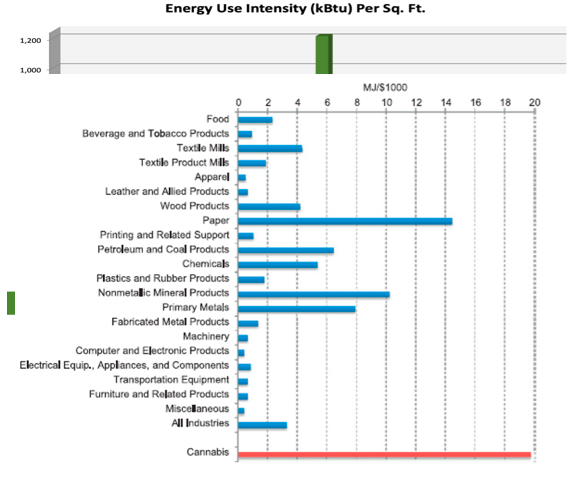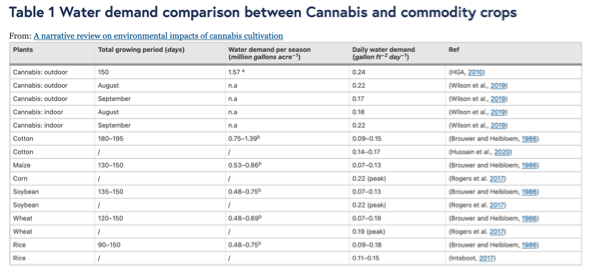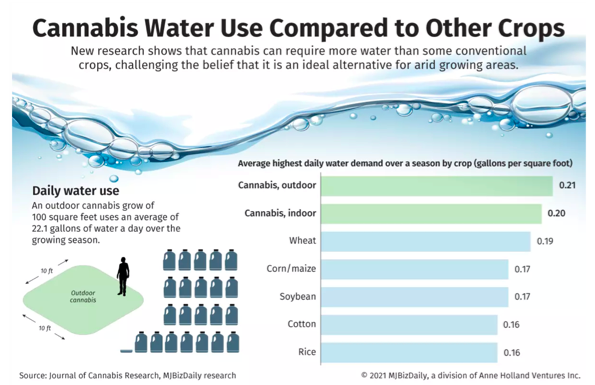Author: Hymowitz, Alexander

Most consumers, regardless of what they are buying, be it, groceries, clothing, or vehicles, do not think about the stress that the product puts on the utility grid producing that product.[1] The same is true of cannabis consumers and cannabis.
Oftentimes when a cannabis user, purchases cannabis flower, or a cannabis related product, a recent study shows, the purchaser does not think about the stress the product puts on the local utility grid.[2] In other words, the average consumer does not consider how much water it takes to properly irrigate the soil used to grow cannabis nor do they think about the amount of electrical wattage hydroponic grow sites consume nor do they think about the nutrient waste pollution that cannabis producers must properly dispose of nor do they consider the amount of pollution that retail, distribution, delivery and the rest of the cannabis market actually produces. Frankly, cannabis is not as environmental as many users believe it be.[3]
The issue is, the stress cannabis production has begun to put on local utility grids has become so problematic that states, such as California and Massachusetts, have begun to regulatorily, legally and physically combat cannabis producers because of their impact on local utility grids.[4][5] In fact, some counties, such as Humboldt County, California have gone as far as to specifically limit the amount of water cannabis farms can receive.[6] These water, electricity and waste disputes have escalated to full blown water wars.[7] Although fact finding in this area is notoriously difficult[8], it is abundantly clear that cannabis production has a tremendous impact on the electrical, water, and waste grids of local communities. In fact, many communities who previously only saw the benefits that cannabis legalization could bring, are beginning to see the stress cannabis production can put on their local utility grids. However, certain municipalities and cities are taking precautions to ensure safe, environmentally cautious cannabis production. This paper is not intended to offer alternative measures, but rather is intended to act as a form of a warning to cannabis consumers, growers, cultivators, and anyone entering the cannabis business, from plant-touching to paper-only, the cannabis business needs to drastically change before we create an irreversible environmental impact in pursuit of cannabis.
The Environmental Cost of Cannabis

It should be noted that although there is outdoor grow, which is considerably more eco-friendly, indoor cannabis growing allows the grower to completely control the environment, including temperature, light source, Carbon Dioxide levels, and humidity, without having to worry about weather.[14] Indoor grow cannabis typically produces flower with higher THC percentages and thus, a “better” product.[15] Indoor cannabis has been the choice for most cannabis growers because indoor growing also produces a consistent quality product that can be easily replicated and sold. Nonetheless, the growing comes at a huge expense to the utility grids that help create that product.
Although the customer tends to focus solely on the cost of the product at the door, recent studies have begun to demonstrate that the “normal” consumer is interested in an environmentally neutral product.[9] However, cannabis is anything but environmentally friendly. Per $1000 of produced product, cannabis is the most comparatively energy intensive commodity industry there is, by a far margin.[10] In fact, preliminary tests show that a single serving of THC that was grown indoors —
roughly ten mg of dried cannabis — is likely to have higher greenhouse gas emissions than a serving of beer, wine, spirits, coffee or cigarettes, regardless of the location the cannabis was grown.[11] Cannabis researchers have synthesized certain regions of the United States are, in fact, slightly heating up, because of cannabis greenhouse gas emissions.[12] These same researchers have found that greenhouse gas emissions from cannabis production are largely attributed to (1) electricity production, (2) natural gas consumption from indoor environmental controls, (3) high-intensity grow lights, and (4) supplies of carbon dioxide for accelerated plant growth. This study, out of the Colorado State University, clearly and concretely raises concerns regarding the environmental impact cannabis growth and cultivation has on the electrical, water, and waste grids. Opponents of the study state that it is an underestimation of the environments impact of cannabis because the study does not account for, “storage, delivery and the illegal market”.[13] In anything, the study would then be under accounting for the environmental impact. Nonetheless, it is clear, the way cannabis is being grown now is a clear environmental disaster.
The Electrical Grid
The cannabis industry consumes a humongous amount of electricity. The most interesting part about cannabis and electricity use is how constant it has remained. For instance, in 2015, the average electricity consumption of a 5,000-square-foot indoor facility in Boulder County was 41,808 kilowatt-hours per month, while an average household in the county used about 630 kilowatt-hours. This is nearly a 6,500% increase in electricity usage.[16] Although this may sound staggering, the overall electrical use amount is even more absurd. A 2012 report on the electrical usage of indoor cannabis production found that cannabis production makes up one percent of national electricity use, and in California, the top-producing state, that number rises to three percent.[17] This electricity usage is similar across the globe. For example, Terry Young, vice president of policy, engagement, and innovation at the Independent Electricity System Operator (“IESO”), which operates Ontario’s power grid in Canada explained in an interview, “The cannabis industry consumed a total of 93,000 MWh of electricity in 2018 and is expected to grow by 1,250% by 2024 to 1,258,000 MWh. By 2024, consumption from the cannabis industry is expected to total just under 1% of the province’s total power consumption.”[18]
Not only is electricity expensive, but if too much stress is placed on the electricity grid at one time, it can cause shortages, which can cause major issues. In 2015, The Portland, Oregon-based utility company, Pacific Power, said that since cannabis became recreationally legal over the summer, it has experienced seven blackouts attributed to indoor operations overloading local circuits.[19] The electrical grid stress isn’t going to end any time soon as is evidenced by the same exact electrical blackouts occurring again in 2020.[20] In fact, some electrical grid companies have had to prematurely replace equipment due to cannabis stress on the system.[21] Scholars have noted that the (1) additional stress and (2) the premature replacement of pieces have added to the “normal amount” of. greenhouse gas emissions that electrical grids have produced.[22]
State Specific Responses to the Electrical Grid Crisis
Another major concern regarding grid stress that the cannabis industry is putting on the electrical grid is that no state has tackled this issue. As of 2021, out of the 19 states to permit recreational use of cannabis, only Massachusetts and Illinois, have included energy-efficiency standards for indoor cultivation, a practice that requires nearly nonstop use of lights and various heating, ventilation, and air conditioning systems.[23] Oregon, on the other hand, only requires that growers estimate and then report back on their energy use. None of these states have ever fined or revoked a license for an electrical use infringement.[24]

State specific responses to the electrical grid issue widely vary in both scope and strength. Certain states like Illinois and California have become hawkish about the amount of electrical wattage that cannabis cultivators use because of the potential outages. In fact, California is the first state to require that indoor growers switch their lights. Specifically, the proposed updates to California Title 24 would require indoor horticulture lights to have an efficiency rating of 2.1 umol/j by January 2023.[25] This is achievable only by replacing all a facility’s lights with the most efficient LED lights available today. Other, more lenient states, such as Oregon, only suggest that a cannabis grower reduce electrical wattage usage and keep track of their electrical usage.
As it stands now, cannabis growers, producers, cultivators, both legal and illegal, are acting with impunity towards how they treat the electrical grid. This impunity and electrical grid stress are wreaking havoc on the environment, simply because of the sheer amount of electricity that the growing of cannabis requires.[26] Indoor cannabis cultivation is 500 times more energy intensive than aluminum smelting, and energy per unit floor area is 50–100 times that of homes and offices.[27] In other words, cannabis cultivation uses more energy than industrial manufacturing and office and residential development. If left unstudied and unattended, the electrical stress that cannabis requires will wreak havoc on the electrical grids and the environment. Therefore, as more states legalize different methods of marijuana usage, states must create strict electrical guidelines that growers, producers, couriers all rigorously abide by.
The Water Grid
Cannabis is a particularly thirsty plant; To cultivate a single cannabis plant to harvest indoors requires about 450 gallons (1,710 liters), and about twice that much outdoors — several times greater than the daily water consumption of an individual in the United States.[28] Although it is particularly hard to quantify, researchers have estimated that each specific cannabis plant requires almost 6 gallons of water a day to grow.

[29] The issue begins to reveal itself when you look at the number compared to the amount of water required to grow other commodity crops like corn, wheat or rice. Cannabis growing far exceeds the water needs of many commodity crops. For example, cannabis in a growing season needs twice as much as the water required by maize, soybean, and wheat.[30] Water is an already scare commodity in an area that frequently goes through droughts and is heavily reliant upon rain for fresh water. Cannabis and water usage is such a hotly contested issue that water wars and court cases have been waged over it. Take for example, Lo v. County of Siskiyou, in the U.S. District Court for the Eastern District of California. The recently decided case revolved around a county passing local ordinances and resolutions intended to “root out illegal and water-intensive cannabis cultivation during a severe drought.”[31] The ordinances were challenged by a group of cannabis growers, who all happened to be members of the local Hmong community. The county estimated that over 3 million gallons of water were being used to grow illegal cannabis. The county uncovered proof that the cannabis growers were illegally drilling into the groundwater reservoirs and using that water for the cultivation of cannabis.

The petition to have the ordinances reversed was denied because the court found that “illegal cannabis cultivation is an unsustainable drain on scarce groundwater resources during a drought.”[32] The Hmong population in the region can get water trucked for basic living requirements, up to 100 gallons, but are unable to get water for cannabis cultivation. In other words, the federal court recognized that water is a hugely important commodity that requires significant protection by the United Stated government. These are only the illegal growers and the stress that they are putting on the already struggling water grid is enough to require federal intervention.
State Specific Responses the Cannabis Water Consumption Issue
In 2015, the North Coast Regional Water Quality Control Board, one of nine regional boards of the California State Water Resources Control Board, developed a Cannabis Waste Discharge Regulatory Program to address cannabis cultivation’s impacts on water, including water depletion and water quality degradation. A key feature of the cannabis program is an annual reporting system that requires enrollees to report the water source(s) they use and the amount of water they use each month of the year. Enrollees are further required to document their compliance status with several standard conditions of operation established by the cannabis program. These include a Water Storage and Use Condition, which requires cultivators to develop off-stream storage facilities to minimize surface water diversions during low flow periods, among other water conservation measures. Other states, such as Oregon, have required that prior to licensure, a cultivator or grower is required, as part of their application, to demonstrate legal water or riparian rights.[33] Other states such as Massachusetts and New York have created water use “best practices” and have incentivized good water use practices.[34]
Although states have done a respectable job of protecting water, so long as cannabis continues to be a large business and more states legalize, water, and the stress cannabis production has put on the water grid, will continue to rise. Water scarcity is already a very immediate issue for most states in the western United States and with the amount of water that cannabis growth necessitates, it can be argued that cannabis is acting as a stressor on the water grid. A majority of the 39 states that have legalized recreational adult-use marijuana have not instituted some sort of water use policy, even though most recreational states have experienced droughts in recent years.[35]
The Waste Grid
Like any other business marijuana establishments generate a variety of different waste products. The cannabis industry is known to produce waste in the form of (1) liquid, (2) solids and (4) “green” waste[36] that falls under two categories (A) Biohazard and (B) Non-Biohazard. “Green waste” comes from growing operations and are specifically cannabis stalks and roots, trimmed materials, along with contaminated, spoiled, or damaged plants.[37] Biohazard cannabis waste comes in the form of vape pens and cartridges and their batteries, cannabis bioproducts, such as solvents and plastics. Although the amount of waste is hard to quantify because most states do not require that cannabis producers review their waste production, however, between 2014 and 2017 Washington state created 1.7 million pounds in “green” waste.[38] Undoubtably the amount of liquid, biohazard and solid waste was more than just the amount of “green” waste.
GAIACA Waste Revitalization claims to be the nation’s first licensed cannabis waste disposal company that composts plant stems, leaves, and re-purposes product packaging materials. GAIACA believes that with all these materials combined, the cannabis industry can generate approximately 150 million tons of cannabis related waste each year, nationwide.[39] This amount of waste is equal to half of the total generation of municipal solid waste (“MSW”) in 2018. If this information is true, cannabis production will put a ton of extra stress on the waste management system. This amount of stress could cause catastrophic meltdowns and stoppages of waste treatment, sorting and management facilities.
State Specific Responses to Cannabis Waste
Many states have begun issuing guidance and regulations regarding cannabis waste and its management. For example, Massachusetts has issued guidance to that state’s cannabis companies on waste management requirements, as have Oregon, California, Washington, New Hampshire, New York, and Colorado. However, that accounts for only 7 out of 39 states with legalized marijuana use, which is a measly 17%. Clearly, not every state that has legalized cannabis has created some form of regulations involving cannabis related waste. However, the issue gets worse when one looks closely at the states that have created some form of waste related regulations. Take for ex
California, which is expected to account for nearly one-fourth of all cannabis sales growth in the US by 2024, has three different state agencies with their own sets of regulations and their own cannabis waste management requirements. Those regulations require the state to reduce cannabis related waste by 50% by 2020, and by 75% by 2025. This regulation was snuck under the larger Mandatory Commercial Organic Waste Recycling Law (“COWR”). COWR became effective on January 1, 2016, and requires businesses and multi-family complexes (with 5 or more units) that generate specified amounts of organic waste (compost) to arrange for organics collection services. COWR also places penalties and fines on companies and locations that do not abide by the state regulations.[40]
New York, with their recent legalization, was on the forefront of a new cannabis waste management discussions. Prior to the passage of the Marijuana Regulation and Taxation Act, New York legislature discussed requiring all cannabis packaging in New York to be made from at least 50% recycled materials. It would also require retailers to put in place a system where they can collect old bottles and jars from consumers. That process of reusable packaging returned to the point of purchase is already in the works for formerly single-use-heavy industries like fast food.[41] New York has severely retreated on their cannabis waste management discussions and have settled on requiring the Office of Cannabis Management consider “climate resiliency and minimize or eliminate adverse environmental impacts, including but not limited to water usage, energy usage, carbon emissions, waste, pollutants, harmful chemicals and single use plastics” when considering new license applicants.[42]
There have been many different approaches to closing the cannabis waste production loop, however, not one state has been able to decrease their cannabis related waste since legalization.[43] Without figuring out how to cut down on the amount of waste that cannabis producers, cultivators and the rest of the industry is producing, the cannabis industry, as a whole, will continue to put tremendous stress on the waste management grid by adding millions of additional hazardous and non-hazardous waste to the system.
Conclusion
Cannabis legalization has brought with it many great things such as additional streams of revenue for states, criminal conviction expungement for convicted marijuana felons, increases in tax streams and many other benefits. However, with all these benefits came some negatives such as the humongous amount of stress cannabis growth and production puts on local utility grids, especially the water, electrical and waste grids. Stress on utility grids is a major negative impact as it can disrupt everyday civilian life by bringing about electrical blackouts, droughts, and waste overruns. Although some states, like Oregon and Colorado, that have legalized cannabis production have been quick to create guidelines and regulations to help limit the amount of stress that a cannabis grower can put on a local utility grid it may be too little too late. As more states begin to legalize cannabis production it is critical that they set up regulatory frameworks that put their utility grids front and center of the growing process because if they do not, states will be subject to horrific repercussions. As more states legalize marijuana, and federal illegality remains constant, the United States will continue to remain a checkerboard of different regulatory schemes, policy incentives and policing bodies.
SOURCES
[1] Castillo, A., 2021. Report: Disparity in Perspectives Among Utility Officials, Consumers, When It Comes to Electric Grid Challenges. American City and County.
[2] Mills, E. and Zeramby, S., 2020. Energy Use by the Indoor Cannabis Industry: Inconvenient Truths for Producers, Consumers, and Policymakers.
[3] Carah, Jennifer K., et al. 2015, “High Time for Conservation: Adding the Environment to the Debate on Marijuana Liberalization.” BioScience, vol. 65, no. 8, [American Institute of Biological Sciences, Oxford University Press], pp. 822–29
[4] Howland, E., 2021. This Is the Grid. This Is the Grid on Legalized Marijuana. Any Questions? Utility Dive.
[5] Publicpower.org. 2021. Utilities Grapple with Growth in Cannabis Legalization. American Public Power Association.
[6] Witt, E., 2021. How Legalization Changed Humboldt County Marijuana. The New Yorker.
[7] Weinberg, B., 2021. California’s Water Wars & Cannabis: Will Small Growers Be the Losers? Cannabis Now.
[8] Whitcomb, T., 2021. In Clashes Over Cannabis, Race, And Water, Hard Data Is Scarce. Salon.
[9] Butler, A., 2021. Council Post: Do Customers Really Care About Your Environmental Impact? Forbes.
[10] Mills, E., 2012. The Carbon Footprint of Indoor Cannabis Production. Energy Policy, 46, pp.58-67.
[11] Quinn, J., & Summers, H. (2021). What’s The Carbon Footprint of Cannabis? Surprisingly High.
[12] Ibid.
[13] Timmer, J. 2021. As A Crop, Cannabis Has Enormous Carbon Emissions.
[14] Eichhorn Bilodeau, S., Wu, B. S., Rufyikiri, A. S., MacPherson, S., & Lefsrud, M., 2019. An Update on Plant Photobiology and Implications for Cannabis Production. Frontiers in plant science, 10, 296.
[15] Gorman, C. 2021. Where’s A Better Environment to Grow Weed: Indoors or Outdoors?
[16] Bade, G., 2021. Pot Power: How Utilities and Regulators Are Dealing with The Budding Marijuana Industry. Utility Dive.
[17] Ibid.
[18] Tunnicliffe, A., 2021. Off-Grid: How Soaring Cannabis Markets Are Forcing an Energy Rethink. Power-technology.com.
[19] Walton, R., 2021. Marijuana Grow Houses Trigger 7 Summer Outages for Pacific Power. Utility Dive.
[20] Pacificpower.net. 2021. Power Restored to Customers in Weed, California Area After Public Safety Power Shutoff.
[21] Gordon Friedman, Nov. 5, 2015, Pot Grows Strain the Electrical Grid, Statesman J. (Salem, Or.), at A1.
[22] Warren, G., 2021. Hotboxing the Polar Bear: The Energy and Climate Impacts of Indoor Marijuana Cultivation.
[23] Energy News Network. 2021. Most States Legalizing Marijuana Have Yet to Grapple with Energy Demand.
[24] Bryce, R., 2021. How Cannabis Farms Steal Megawatts to Grow Mega-Weed.
[25] C.A. 2022 Title 24, Part 6.
[26] Cannabis and the Environment: What Science Tells Us and What We Still Need to Know” Evan Mills Environmental Science & Technology Letters (6), 483-485.
[27] Mills, E. Zeramby, S. Energy Use by the Indoor Cannabis Industry: Inconvenient Truths for Producers, Policymakers, and Consumers. In The Routledge Handbook of Post-Prohibition Cannabis Research.
[28] Felbab-Brown, V., 2021. Pot, Water Theft, And Environmental Harms in The US And Mexico.
[29] Michelson, A., 2021. The Cannabis Industry Is Not as Green as You’d Think.
[30] Zheng, Z., Fiddes, K. & Yang, L., 2021. A Narrative Review on Environmental Impacts of Cannabis Cultivation. J Cannabis Res 3, 35.
[31] Lo v. Cnty. of Siskiyou, No. 2:21-cv-00999-KJM-DMC (E.D. Cal. Jun. 15, 2021).
[32] Ibid.
[33] 2021. Options for Obtaining Water Legally: An Overview for Hemp, Medical Marijuana and Recreational Marijuana.
[34] Mass-cannabis-control.com. 2021. Guidance on Best Management Practices for Water Use.
[35] Drought.gov. 2021. Historical Data and Conditions.
[36] Mass-cannabis-control.com. 2021. Guidance on Best Management Practices for Water Use.
[37] Kennedy, B., 2021. The Cannabis Industry Generates Tons of Extra Waste. Here’s Why. Leafly.
[38] Black, L., 2021. Washington’s Weed Industry Has a Million-Pound Waste Problem. The Stranger.
[39] GAIACA. 2021. Environmental Impact of Marijuana on Our Planet Examined.
[40] Assembly Bill (AB) 1826.
[41] Menapace, B., 2021. NY Assembly Introduces Cannabis Packaging Legislation to Limit Waste. Promo Marketing.
[42] S. 854-A § 64(g).
[43] Voss, E., 2021. Cannabis Waste: A New Frontier (WasteExpo 2019). Waste360.




